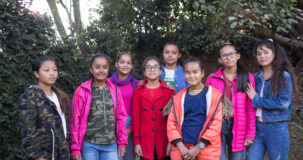
Home » #HerTurn 2017 Campaign
October 11th is the International Day of the Girl. It’s a day to bring the world’s attention to the discrimination and violence many girls face through situations like early marriage, in emergencies, or in the struggle to access education. But this day is also about celebrating girls’ potential, creativity, courage, and determination. In 2017, to celebrate the International Day of the Girl, we paired up with People in Need to introduce some of the girls we work with. We think girls are important all year round, but on this day especially we highlight these amazing girls’ ideas for the future.
We asked 14 rural Nepali girls what they would do if they were in charge of their family, their community, their village, their country, or the world. We will be introducing them in the gallery below.
#HerTurn #Unstoppable #DayoftheGirl
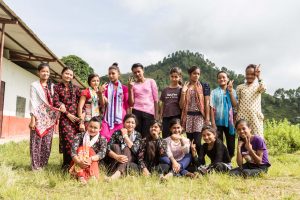
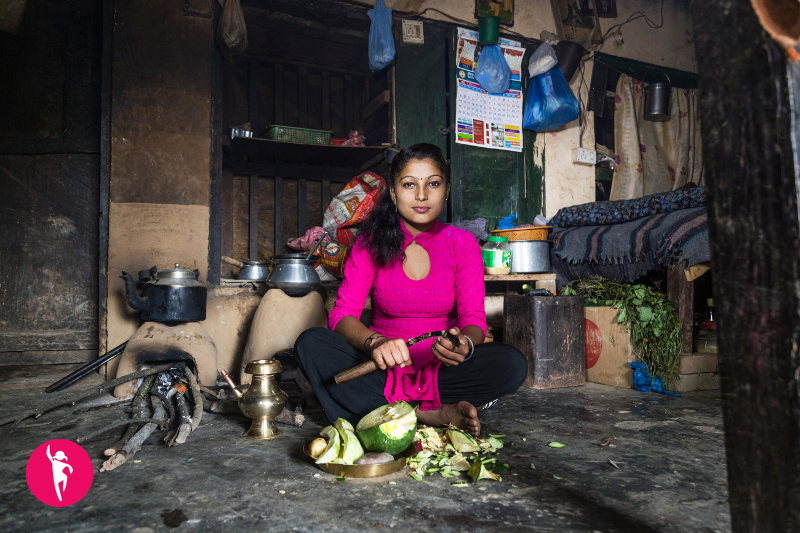
Sushma, 16, is determined to end menstrual taboos because #menstruationmatters
‘When we have our periods, we are not allowed to enter the kitchen and touch men in the family. I asked my grandmother why and she said our culture does not approve it, because we are “untouchable” while menstruating. I think all girls should be proud to menstruate because it makes girls stronger and able to reproduce. If I were in charge of the community, I would work to eliminate menstrual restrictions. I believe I can do it; in ancient times, women were forced to jump on their husband’s funeral pyres, but we have eliminated that practice. I would coordinate with local government officials, organize door-to-door campaigns, and mobilize men in this campaign because they could support women and girls during the days of their periods. I would also conduct trainings for adolescent boys about menstruation. Some boys laugh at us when we have stains on our clothing. Everyone should know that menstruation is natural.’
For too many girls, their first period is an embarrassing and scary experience. In some contexts, including some communities in Nepal, taboos around menstruation – for example, the belief that menstruating girls must not touch books – keep girls out of school. This natural and healthy body function can be a big obstacle to education – 95% of girls in Ghana and 51% of girls in Ethiopia miss school during their periods. Many girls cannot manage their periods with safety and dignity because their schools lack proper toilets without water, soaps, privacy, and space to change, and lack of menstrual hygiene materials. Many also report stress, low self-esteem and inability to focus in class. These challenges affect girls’ academic performance and can lead to dropping out of school altogether. Education about menstruation – for girls and boys – and ensuring girls have proper toilets with soap and water, menstrual hygiene materials, and a private space to change can make a big difference.

Sushma, 15, is advocate for equality for all and fights #castediscrimination
‘My family belongs to an “untouchable” caste. Once, a villager invited us for a feast, but we were asked to sit separately. We felt humiliated. Another time, I was stopped from drinking water at the public tap. I felt like I didn’t have the right to use it; I kept silent and returned home. If I were in charge, I would work to eliminate untouchability since it is ingrained in the community. I would set a meeting with mother’s groups and social clubs and post awareness messages around the public taps, like “stop untouchability.” Additionally, we would campaign door-to-door in the community. I would take my biggest step by making policies to penalize people who practices untouchability.
The caste system is a traditional social structure through which individuals are assigned a rigid position by birth that can determine everything from their job, to whom they can marry, or even accept food and water from. Although illegal, it is prevalent in South Asia and some other regions. The most oppressed group within the caste hierarchy are Dalits – “Untouchables,” who are considered impure and polluting by some in higher caste groups. India’s Dalit community exceeds 170 million people. They traditionally often work as scavengers, removing human waste, artisans, or street sweepers. Two thirds of India’s Dalits live in poverty. The group faces many forms of discrimination, such as segregation in schools, bans from using village water sources, or bans from marrying members of other castes. Issues affecting adolescent girls and boys, like limited access to school and early marriage, are more prevalent in Dalit communities.

Meet Shobha, 15, maternal health activist
‘Women in rural areas have poor access to health facilities. They don’t receive proper care and support from their families and communities due to different social and domestic circumstances. Even if they are in pain, they stay busy gathering animal fodder, collecting water, and chopping wood. If I were in charge of the country, I would mobilize female community health volunteers to help pregnant women and new mothers for two years. They could help her with domestic work, and support her pre- and post-natal care, making sure she gets nutritious food and good rest, so that no pregnant woman needs to suffer miscarriage or health complications. I would also work with supporting organizations to establish birthing centers so women in remote areas can access health services. I think this would be a ray of hope to pregnant women.’
While in the last two decades there has been an incredible progress globally in maternal and infant health, 830 women still die every day of preventable causes related to pregnancy and child-birth. That’s more than two women every minute. About a million girls below the age of 15, and 16 million more 15-19 year olds give birth every year. This puts them at risk of various health complications – like obstetric fistula or uterine prolapse – and makes their babies less likely to survive to the age of 5. When adolescent girls and boys receive quality, age appropriate sexual and reproductive health education, they – and their future families – stay healthier.

Sujata, 14, cares about safety and has plans to combat #violence
‘If I were in charge of the community, I would establish a women’s police station. With the help of female police, I would work to bring awareness among people on laws related to harassment and sexual abuse, and provide trainings to the police on these issues to hold them accountable. I would also establish a safe home for survivors of violence and people with disabilities.’
Violence will affect one in three women and girls throughout their lifetime. It can occur at any stage of life and take many forms, such as early marriage, domestic violence, sexual harassment, female genital mutilation, marital rape, or school related violence. The consequences can be serious: injuries, sexually transmitted infections, depression, and anxiety. Survivors often struggle to seek help – either because of stigma and shame, or because help is not available. Studies show that only 7% of women who experience violence report it, with large differences between regions – in India the figure is only 2%. Both community members and police need to know the laws against violence and push for their enforcement.

Romina, 15, plans to start women’s cooperatives to fight #poverty
‘Nepal is an agricultural country. Most of the people are heavily dependent on agriculture. My family is also dependent on agriculture. If I were in charge of this area, I would establish a women’s agricultural co-operative. The co-operative would provide training on commercial animal husbandry, use of pesticides and fertilizers, and improved seeds, technology, and farming methods. We would also try commercial seasonal farming like oranges, mushrooms, and grapes. We would provide agricultural credit to people with minimum interest, establish storage houses, and extend the market in the area. I believe this will improve the quality of life here.’
250 million adolescent girls live in poverty and poverty is concentrated in farming communities around the world. More than half of poorest girls in developing countries are married before they reach 18. Girls living in poverty have a three times higher chance of being married as children than girls from wealthier backgrounds, they are more likely to be burdened with intense household work and drop out of school, and have little economic opportunities. But adolescent girls also have potential to end poverty – investing in girls unleashes their potential as it lets them stay in school and become healthy and safe citizens who are able to strengthen their countries’ future economies.
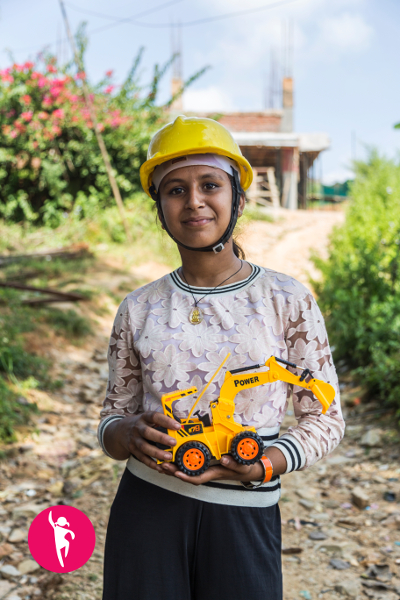
Asmita, 15, envisions roads to connect Nepal’s villages
‘A road is not only something to step on; it is our development need. Our roads are muddy and steep, with dangerous geographical features. There are villages in Nepal with no road access. Some students have to spend two hours walking each day to go to school. If I were in charge of my community, I would construct a road and extend its network to all places. I would consult with researchers, environmentalists, educators, government agencies and cultural experts to make the road sustainable. There would be trees on both sides of the road. I would make sure there were enough bulldozers in the village to keep the road in good condition during monsoon season. The road would also be a place for awareness; I would paste banners and pamphlets on conserving the environment and stopping violence. But I would also focus on foot trails because people love walking those routes.’
Across the world, girls and women are underrepresented in science, technology, engineering and math (STEM) fields – globally less than 30% of researchers are women. The reasons vary across countries, but there are several common threads: gender stereotypes often perpetuated by curricula and learning materials, parents’ and teachers’ expectations and biases, and a lack of female teachers and role models in STEM fields. All these can affect girls’ confidence and career plans. Women in STEM fields are important – they work on solutions to the current major global challenges such as climate change, public health problems, and social inequalities. They also become mentors and role models to girls with ambitions to become engineers, scientists, and mathematicians.
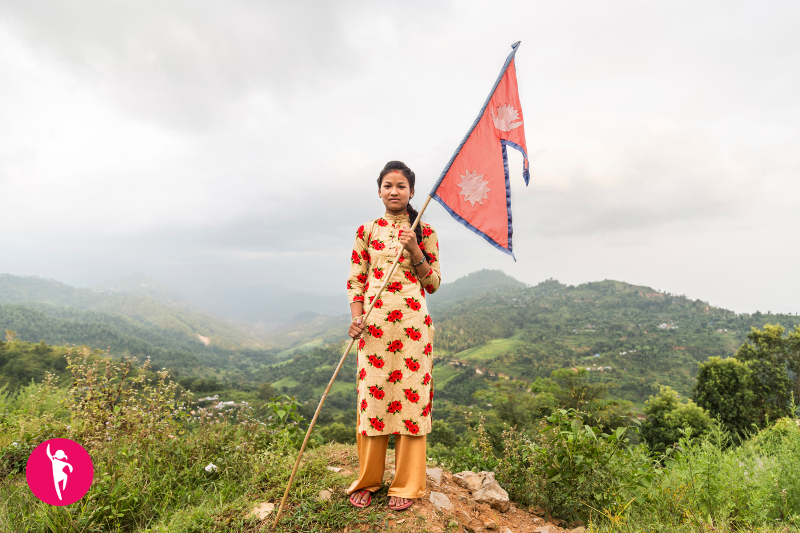
Sajina, 14, is #transparency advocate
‘Healthy politics are the backbone of development. I get confused and want to know where the development budget goes. Our community lacks proper roads, water supply, communication, and market facilities. It does not seem transparent. If I were in charge of the country, I would work to make the political condition stable. I would form an investigation committee to monitor each department in central and local level government. I would check how, why, where, who and what is happening in all sectors through the committee to stop corruption. We have legal provisions and policies on social development, human trafficking and child marriage but we have loopholes in implementation. For this, I would make all the government agencies and political institutions more accountable and responsible. I think this would be a good step for political stability in Nepal.’
In most regions of the world, women and girls are underrepresented in leadership positions. Globally, less than a quarter of parliamentarians are women, but there are places where this is changing: in Rwanda, over 63% of parliament seats are held by women. Women in positions of power make a difference: in India their participation in local councils increases access to drinking water, while in Norway it was linked with childcare coverage. Each year, corruption, bribery, theft, and tax evasion in developing countries sum up to USD 1.26 trillion. While there is no evidence that either men or women are more corrupt, studies show that women can reduce corruption if they are represented in policy making positions. “You can’t be what you can’t see” – women in leadership and politics also become role models for girls who want to change the world.
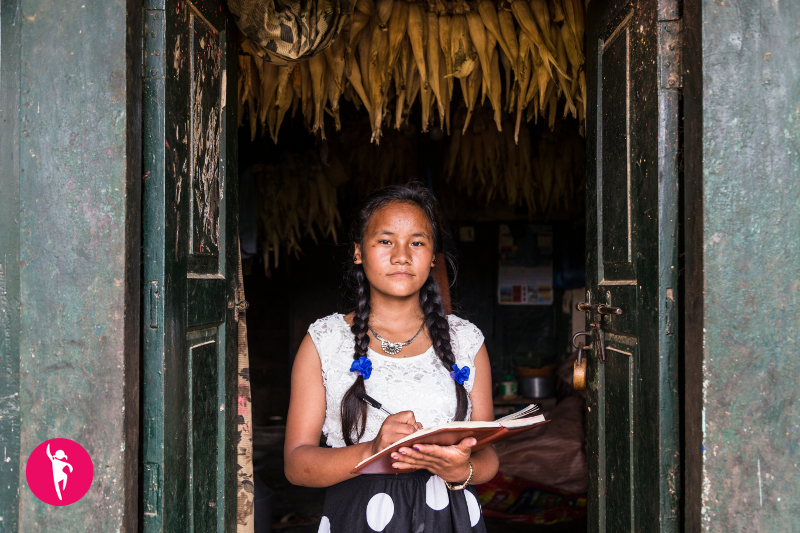
Meet Nanu, 14, anti #domesticviolence advocate
‘The problem I see in my community is domestic violence – for example, husbands beating and emotionally abusing wives. If I were in charge of the community, firstly I would collect data regarding domestic violence. Then, I would invite men and women from every household, tell them about the laws against domestic violence, and show them a drama on the consequences of domestic violence. I would also establish a separate office for reporting cases of domestic violence where the lawyers would provide free service.’
Domestic violence is one of the most prevalent forms of violence against women and girls; it’s also a hidden one. Around the world, 30% of women who have been in relationships have experienced violence from their partners. The consequences can be devastating and include: sexually transmitted diseases, including HIV, premature births and low birth weight, depression, and suicide or homicide. The forms of violence against women and girls and its prevalence differ between communities, countries, and regions. This means violence can be prevented; social norms that affect its prevalence can be transformed. Studies show that social norms that perpetuate men’s control over women and girls, social acceptance of violence, and perpetrators’ exposure to violence in childhood are some of the most important driving factors. School based prevention programs that address intimate partner violence are one strategy shown to reduce domestic violence.

Binisha, 13, advocates for healthcare in remote villages.
‘People are forced to go far away to the city for even minor operations, and ambulances are not available all the time. If I were in charge of the community, I would build a hospital with the support and co-ordination of children and youth clubs, mothers groups, and the Red Cross. I would fill it with equipment and experts for conducting operations. Once a month, I would conduct health camps in all the villages.’
Mothers in developing countries are 14 times more likely to die in childbirth than in other parts of the world. Adolescent girls and women under 24 are twice as likely to be at risk of HIV than boys and men their age. In Africa alone, malaria kills 10,000 pregnant women and 200,000 of their babies each year. Lack of healthcare infrastructure and poor systems can be one reason, but social and cultural factors can also prevent women and girls from accessing health services. In some communities, women and girls are less likely to have an equal say in their families in making decisions that relate to their health, such as family planning. In some, they are not allowed to visit health posts or take their children there, without a partner’s permission. Improved and equal access to healthcare is needed to address many global public health issues such as malaria, infant diarrheal disease, and HIV/AIDS. Health systems can also play an important role in addressing violence against women and girls when health workers are trained in detecting violence in patients and in survivor centered response that ensures confidentiality, privacy, dignity, and choice.

Alina, 19, is an advocate for #cleanwater = disease prevention
‘Water is the biggest problem in our community. We feel so happy if we see a tap with water. Normally, we have to walk an hour uphill for water. It’s a big problem when we get stains during our periods. We girls have to run to a friend’s house nearby to use a toilet during school. It has been a great problem to us when blood stain on our cloth during menstruation. If I were in charge, I would hold a meeting with all households of the community, and coordinate with the local government to collect money to develop our water supply. I would do door to door campaigning with the help of health centers on water purification and prevention of water borne diseases like jaundice and typhoid.’
Women and girls are disproportionately affected by water and sanitation issues. In most communities in Africa and Asia they are responsible for water collection – many spend hours every day fetching water. This time could be used on income generating activities, childcare, or going to school. Water and sanitation affects maternal and infant health – because of insufficient water and sanitation, diarrhea still kills over 360,000 children under 5 years of age every year. Water and sanitation is essential for safe and dignified menstrual hygiene management, and without safe and private toilet facilities, girls miss school or end their educations early. Water is also directly tied to women’s and girls’ safety; since they are the ones responsible for fetching water for their households, traveling distances alone they risk violence and harassment.

Menuka, 16, will fight for fair and safe work conditions for #migrants
‘Our community views female migrant workers and returnees negatively. There were a few cases where women were trapped in poor working conditions abroad and didn’t earn much money, so people asked questions. People think female migrant workers only get jobs as housemaids or sex workers. In Nepal, there are many cases where female workers return back to Nepal with HIV/AIDS but they are neglected by society. So, if I were in charge, I would provide employment opportunities for women. If someone wants to work abroad, I would take help from the police, government, and other related institutions to help them follow the procedures so they don’t get trapped. I would also organize street dramas about women migrant returnees, addressing their issues and sharing a message of acceptance and love.’
Approximately half of the 244 million international migrants and 21 million refugees today, are women and girls. 53 million of them work as domestic workers in private households, where many are abused and exploited, working up to 18 hours a day, seven days a week, for extremely low wages. In many countries, domestic workers are not protected under labor laws. Discriminatory laws that ban women from free participation in migration can increase the risks, as some turn to illicit agents and become more vulnerable. To help minimize these dangers, migrant workers should receive pre departure orientations that include work conditions and their rights. Agreements between countries of origin and destination can also help protect migrant workers’ rights.

Ranju, 15, is an advocate for girl friendly schools
School is every child’s second home, and I’m inspired by my school’s principal. If I were in charge of my school I would hold regular trainings for the teachers on positive discipline, refreshing teaching techniques, and ensuring children’s rights and dignity. Students who are good at their studies, and belong to marginalized ethnic groups would get scholarships. There would be gender segregated toilets with access to water, and a separate room for girls where they can rest or change pads during their periods. School would offer extra-curricular activities that interest students, and would mobilize students to conduct awareness programs in the community twice every month. We would surely conduct programs for boys and girls about puberty.’
Globally, 131 million school-aged girls are out of school. Fifteen million of them are missing primary education and will never learn to read and write. Of the children and adolescents who do get to go to school, 246 million boys and girls experience some form of violence there. Girls experience bullying, cyber bullying and sexual harassment at higher rates, while boys are more likely to experience corporal punishment. LGBT students face violence based on their sexual orientation or gender identity. School related violence can result in physical injuries, lower academic performance, low self-esteem and anxiety, and missing school or dropping out altogether. But there are things that can help: involving boys and girls in solutions, creating policies that promote gender equality and safe learning environments, and strengthening accountability and links between students, schools, and communities.
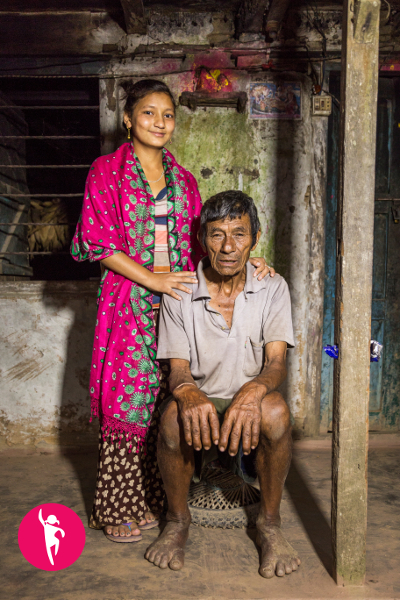
Sabina, 15, envisions social transformation through senior citizens
‘We see many sons and daughters who expel their parents from home when they grew old. They don’t even get proper food, care and support. Elderly people have to go far away if they want to stay at an elderly home. If I were in charge of the community, I would build an old age home and day care center for the elderly. They would receive care, love and support from the home. It would be elderly friendly, with a refreshment room where they can enjoy news, religious songs, dance, and stories. We would also teach them about the need for changing social norms like restriction during menstruation, son preference and other superstitious beliefs. Elderly people are more connected with social norms, values and ideology. We can mobilize them to teach the community about healthier social norms and values, though it takes time to change.’
The world’s population is ageing – people aged 65 or older accounted for 524 million in 2010 and soon there will be more elderly people in the world than children. In many communities, the elderly are influential figures, and if supported, can play an important role in social change pertaining to harmful practices in their communities. Social norms can have strong impacts on girls’ lives, health, and futures. For example, when there are common beliefs around marriageable age for girls, early marriage is likely to be a common practice. Female genital mutilation / cutting (FGM/C) is a procedure that injures female genital organs for non-medical reasons, usually performed on girls under the age of 15. Over 200 million girls and women have been cut in some communities in Africa, the Middle East, and Asia. Son preference practiced in some communities in Asia – where families prefer sons over daughters – results in abortions of female fetuses and female infanticide, and neglect of girls. It is estimated that between 90 and 100 million women and girls are missing today most notably in India, China, but also in other countries, which severely skews sex ratios. This demographic crisis fuels human trafficking of women for wives, and social unrest. While many social norms often limit girls’ opportunities, not all are harmful to the girls, some can encourage and support girls to attend school, and develop life skills.
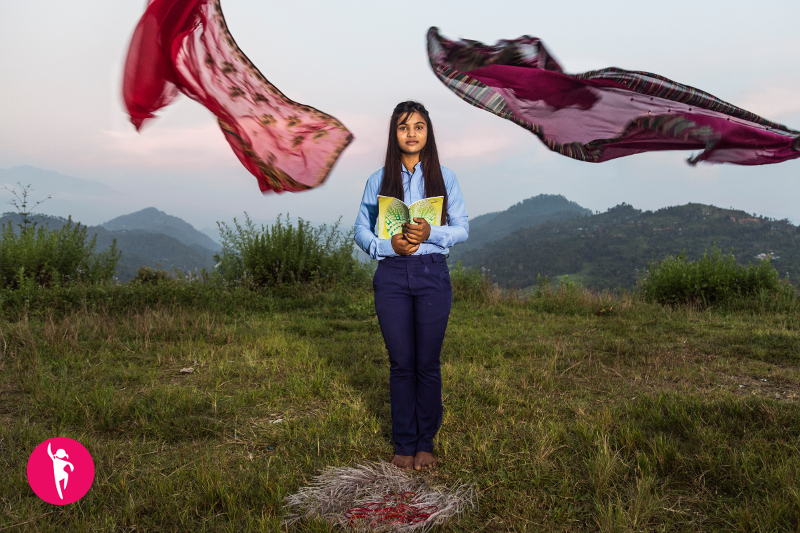
Sarala, 14, is pushing to end #childmarriage
‘I refuse the beauty of a sari and red bangles; I’d rather beautify my world with education. Many girls in Nepal marry underage due to poverty, and cultural and religious factors. Girls often to get pregnant soon after they get married. Child marriage traps girls and narrows their opportunities, and married adolescent girls and boys are teased at school. If I were in charge of a nation, I would mobilize social groups and youth clubs in all areas to stop child marriage and make people aware of the consequences of dropping out of school. Married adolescent girls and boys are teased in school. I would also make schools more welcoming and respectful to married adolescents. I would invest funds to empower youths so that each girl and boy can make their own decisions about marriage. ‘
Each year, 15 million girls around the globe marry before they turn 18. That means 28 girls marry each minute. Child and adolescent brides are more likely to experience early pregnancy and childbirth complications, to remain in poverty throughout their lives, and to experience violence. They’re also much more likely to drop out of school. When a girl is empowered, she stays in school, is able to plan her career, and participates in important and informed life decisions such as marriage and pregnancy. If a girl is educated, her future children are healthier and more likely to be educated, she is more likely to lift herself out of poverty, and she stays safer from a host of risks. Working to prevent early marriage, supporting adolescent brides, and keeping girls in schools is not only the right thing to do, it’s the smart thing to do.
Photography by: Sajana Shrestha / People in Need
@2026. All Rights Reserved by Hamro Palo.